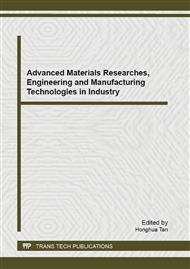[1]
Demirbas, A. D, Biofuels, Trabzon, Turkey (2009) Springer.
Google Scholar
[2]
Anton, A. K., Alexandre, C. D., &Gadi, R. Biodiesel by Catalytic Reactive Distillation Powered by Metal Oxide, Energy & Fuels. Elsevier. vol. 22 (2008), pp.598-604.
DOI: 10.1021/ef700265y
Google Scholar
[3]
D.J. Hayes, S. Fitzpatrick, M.H.B. Hayes, J.R.H. Ross, in: B. Kamm, P.R. Gruber, M. Kamm (Eds. ), Biorefineries—Industrial Processes and Products, vol. 1, Wiley- VCH, Weinheim, (2006), p.139.
DOI: 10.1002/nadc.20060541129
Google Scholar
[4]
G.W. Huber, A. Corma, Angew. Chem. Int. Ed. Engl. 46 (2007) 7184.
Google Scholar
[5]
G.W. Huber, S. Iborra, A. Corma, Chem. Rev. 106 (2006) 4044.
Google Scholar
[6]
Fairous Salleh et al, Bio-Fuel Source from Combination Feed of Sewage Sludge and Rice Waste, 2011 International Conference on Environment Science and Engineering IPCBEE vol. 8 (2011).
Google Scholar
[7]
Kwok-Yuen Cheung, King-Lung Lee, Ka-Leung Lam, Tsz-Ying Chan, Chi-Wui Lee, Chi-WaiHui, Operation strategy for multi-stage pyrolysis, Journal of Analytical and Applied Pyrolysis 91 (2011) 165–182.
DOI: 10.1016/j.jaap.2011.02.004
Google Scholar
[8]
D. Fytili, A. Zabaniotou, Utilization of sewage sludge in EU application of old and new methods—A review, Renewable and Sustainable Energy Reviews 12 (2008) 116–140.
DOI: 10.1016/j.rser.2006.05.014
Google Scholar
[9]
D. Wang, R.X., H. Zhang, G. He: Comparison of catalytic pyrolysis of biomass with MCM-41 and CaO catalysts by using TGA-FTIR analysis, Journal of Analytical and Applied Pyrolysis, 2010, 89, 171-177.
DOI: 10.1016/j.jaap.2010.07.008
Google Scholar
[10]
A. Aho, N.K., K. Eranen, T. Salmi, M. Hupa, D.Y. Murzin: Catalytic Pyrolysis of Biomass In A Fluidized Bed Reactor: Influence of the acidity of H-Beta Zeolite, Trans IChemE, Part B, Process Safety and Environmental Protection, 2007, 85(B5), 473-480.
DOI: 10.1205/psep07012
Google Scholar
[11]
A. Aho, N.K., K. Eranen, T. Salmi, M. Hupa, D. Yu. Murzin: Catalytic pyrolysis of woody biomass in a fluidized bed reactor: Influence of the zeolite structure, Fuel, 2008, 87, 2493-2501.
DOI: 10.1016/j.fuel.2008.02.015
Google Scholar
[12]
Pütün, E.: Catalytic Pyrolysis of biomass: Effects of pyrolysis temperature, sweeping gas flow rate and MgO catalyst, Energy, 2010, 35, 2761-2766.
DOI: 10.1016/j.energy.2010.02.024
Google Scholar
[13]
S. Thangalazhy-Gopakumar, S.A., Ram B. Gupta, M. Tu, S. Taylor: Production of hydrocarbon fuels from biomass using catalytic pyrolysis under helium and hydrogen environments, Bioresource Technology, 2011, 102, 6742-6749.
DOI: 10.1016/j.biortech.2011.03.104
Google Scholar
[14]
Zhang Qi, Chang Jie. Review of biomass pyrolysis oil properties and upgrading research, Energy Conversion and Management (2007).
Google Scholar
[15]
Dang Khanh Vi et al, Bio-oil Production From Rice Husk Via Semi-batch Pyrolysis, The 2nd International Conference on Automotive Technology, Engine and Alternative Fuels ICAEF 2012, 2012, 978-604-73-1496-6, pp.199-205.
Google Scholar
[16]
Ranjit, R., A Primer on the Taguchi Method,. Society of Manufacturing Engineers. (1990).
Google Scholar
[17]
Ross, P.J., Taguchi Techniques for Quality Engineering,. 2nd ed. 1996, United States: McGraw-Hill.
Google Scholar
[18]
Roy, R.K., A premier on the Taguchi Method,. 1990, New York: Van Nostrand Reinhold.
Google Scholar
[19]
Muhammad S. Abu Bakar∗, James O. Titiloye, Catalytic pyrolysis of rice husk for bio-oil production, Journal of Analytical and Applied Pyrolysis (2012), JAAP-2813.
DOI: 10.1016/j.jaap.2012.09.005
Google Scholar


